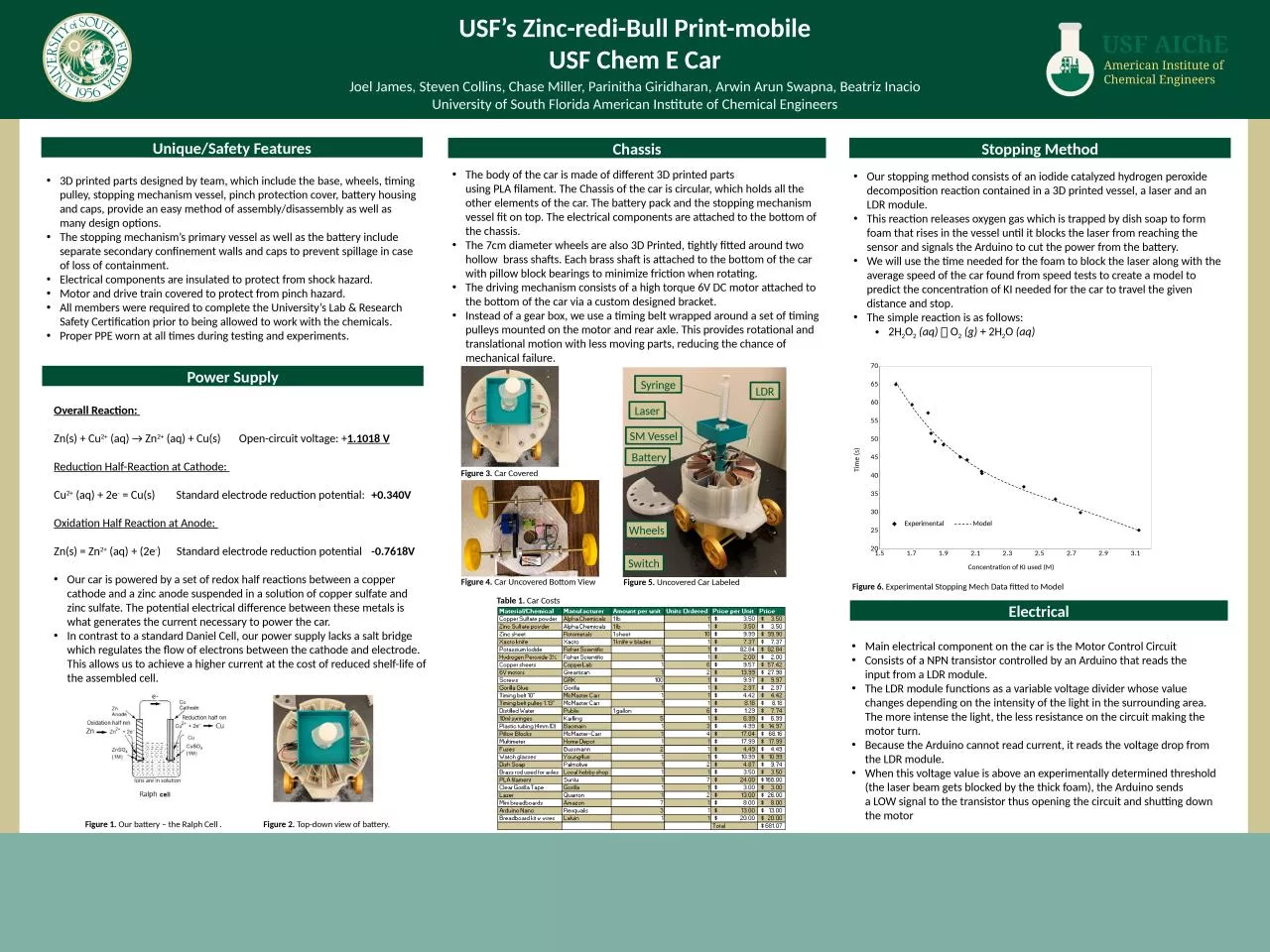

USF Chem E Car Joel James Steven Collins Chase Miller Parinitha Giridharan Arwin Arun Swapna Beatriz Inacio University of South Florida American Institute of Chemical Engineers 3D printed parts designed by team which include the ID: 1015040
Download Presentation The PPT/PDF document "USF’s Zinc- redi -Bull Print-mobile" is the property of its rightful owner. Permission is granted to download and print the materials on this web site for personal, non-commercial use only, and to display it on your personal computer provided you do not modify the materials and that you retain all copyright notices contained in the materials. By downloading content from our website, you accept the terms of this agreement.
1. USF’s Zinc-redi-Bull Print-mobileUSF Chem E CarJoel James, Steven Collins, Chase Miller, Parinitha Giridharan, Arwin Arun Swapna, Beatriz InacioUniversity of South Florida American Institute of Chemical Engineers3D printed parts designed by team, which include the base, wheels, timing pulley, stopping mechanism vessel, pinch protection cover, battery housing and caps, provide an easy method of assembly/disassembly as well as many design options.The stopping mechanism’s primary vessel as well as the battery include separate secondary confinement walls and caps to prevent spillage in case of loss of containment.Electrical components are insulated to protect from shock hazard.Motor and drive train covered to protect from pinch hazard.All members were required to complete the University’s Lab & Research Safety Certification prior to being allowed to work with the chemicals.Proper PPE worn at all times during testing and experiments.Unique/Safety FeaturesThe body of the car is made of different 3D printed parts using PLA filament. The Chassis of the car is circular, which holds all the other elements of the car. The battery pack and the stopping mechanism vessel fit on top. The electrical components are attached to the bottom of the chassis.The 7cm diameter wheels are also 3D Printed, tightly fitted around two hollow brass shafts. Each brass shaft is attached to the bottom of the car with pillow block bearings to minimize friction when rotating.The driving mechanism consists of a high torque 6V DC motor attached to the bottom of the car via a custom designed bracket.Instead of a gear box, we use a timing belt wrapped around a set of timing pulleys mounted on the motor and rear axle. This provides rotational and translational motion with less moving parts, reducing the chance of mechanical failure.Power SupplyStopping MethodMain electrical component on the car is the Motor Control CircuitConsists of a NPN transistor controlled by an Arduino that reads the input from a LDR module.The LDR module functions as a variable voltage divider whose value changes depending on the intensity of the light in the surrounding area. The more intense the light, the less resistance on the circuit making the motor turn.Because the Arduino cannot read current, it reads the voltage drop from the LDR module.When this voltage value is above an experimentally determined threshold (the laser beam gets blocked by the thick foam), the Arduino sends a LOW signal to the transistor thus opening the circuit and shutting down the motorElectricalOverall Reaction: Zn(s) + Cu2+ (aq) → Zn2+ (aq) + Cu(s) Open-circuit voltage: +1.1018 VReduction Half-Reaction at Cathode: Cu2+ (aq) + 2e- = Cu(s) Standard electrode reduction potential: +0.340VOxidation Half Reaction at Anode: Zn(s) = Zn2+ (aq) + (2e-) Standard electrode reduction potential -0.7618V Our car is powered by a set of redox half reactions between a copper cathode and a zinc anode suspended in a solution of copper sulfate and zinc sulfate. The potential electrical difference between these metals is what generates the current necessary to power the car.In contrast to a standard Daniel Cell, our power supply lacks a salt bridge which regulates the flow of electrons between the cathode and electrode. This allows us to achieve a higher current at the cost of reduced shelf-life of the assembled cell. ChassisFigure 1. Our battery – the Ralph Cell .Figure 2. Top-down view of battery.Table 1. Car CostsOur stopping method consists of an iodide catalyzed hydrogen peroxide decomposition reaction contained in a 3D printed vessel, a laser and an LDR module.This reaction releases oxygen gas which is trapped by dish soap to form foam that rises in the vessel until it blocks the laser from reaching the sensor and signals the Arduino to cut the power from the battery.We will use the time needed for the foam to block the laser along with the average speed of the car found from speed tests to create a model to predict the concentration of KI needed for the car to travel the given distance and stop.The simple reaction is as follows:2H2O2 (aq) O2 (g) + 2H2O (aq)Figure 4. Car Uncovered Bottom ViewFigure 3. Car CoveredFigure 5. Uncovered Car LabeledFigure 6. Experimental Stopping Mech Data fitted to ModelSyringeLaserLDRSwitchSM Vessel BatteryWheels